Author Archive
Water level in Fukushima plant’s No. 2 reactor only 60 cm
Tuesday, March 27, 2012
Kyodo, Staff report
The Japan Times
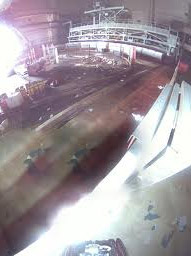
The water cooling the core of the crippled Fukushima power plant’s No. 2 reactor is only 60 cm deep, Tokyo Electric Power Co. said Monday, all but confirming experts’ fears that the unit is breached and can’t hold its coolant.
The utility, better known as Tepco, made the discovery by mechanically inserting a 20-meter endoscope into the primary containment vessel to check its coolant level after failing in January. Water must constantly cover the nuclear fuel core to prevent the rods from melting. The rods in a boiling water reactor of this type are about 4 meters long.
Tokyo Electric Power Co. spokesman Junichi Matsumoto gave assurances that the melted fuel in unit 2 is being constantly cooled by injected water and said the temperature was between 48.5 and 50 degrees. But he also acknowledged that the lower-than-expected water level suggests much of it is leaking from the vessel and into the plant.
This is the second time Tepco has inserted an endoscope into the reactor since the plant was crippled by the core meltdowns triggered by the earthquake and tsunami last March. When an attempt using a shorter endoscope failed to find water level on Jan. 19, the company had to try a longer one to check deeper inside.
The fuel in reactors 1 to 3 is believed to have blazed through the pressure vessels and accumulated in the outer containment vessels. Although the water injected into unit 2 was transparent, some sediment was found, Matsumoto said.
Tepco plans to survey the No. 2 reactor again on Tuesday to check the interior radiation level.
For the first survey in January, Tepco projected the water level had likely climbed to about 4.5 meters, based on the pressure differential between the main body and a lower component. But it failed to detect any coolant water around 4 meters from the bottom.
This document contains copyrighted material whose use has not been specifically authorized by the copyright owner. SEED Coalition is making this article available in our efforts to advance understanding of ecological sustainability, human rights, economic democracy and social justice issues. We believe that this constitutes a "fair use" of the copyrighted material as provided for in section 107 of the US Copyright Law. If you wish to use this copyrighted material for purposes of your own that go beyond "fair use", you must obtain permission from the copyright owner.
Texas officials approve radioactive waste dump
Friday, March 23, 2012
By Jim Vertuno, The Associated Press
Austin American Statesman
AUSTIN, TEXAS — Radioactive waste from dozens of states could soon be buried in a Texas dump near the New Mexico border after Texas officials gave final approval Friday to rules allowing the shipments.
Texas lawmakers in 2011 approved the rural Andrews County site to take the waste and the Friday’s unanimous vote by the Texas Low-Level Radioactive Compact Commission cleared a major hurdle to allow the waste burial.
Texas already had a compact legal with Vermont to take its waste. Environmentalists have argued against expanding the program to 36 more states, warning it could result in radioactive material rumbling through the state on trucks with few safeguards in case of an accident. They also say a problem at the waste dump could lead to potential underground water contamination.
Dallas-based Waste Control Specialists, which owns and operates the site, insists it will be safe. The waste would be entombed in concrete about 100 feet underground in an area with densely packed clay. The site still needs final approval from state environmental regulators, and company president Rod Baltzer said it could happen as early as next week.
Applications to bury waste at the Andrews site must be approved by the compact commission on a case-by-case basis. At least three have already been filed, Baltzer said. If they are approved, material could start arriving in May.
Waste Control Specialists officials say accidents are infrequent when low-level radioactive waste is moved. Data from the U.S. Department of Transportation’s Pipeline and Hazardous Materials Safety Administration show that, from 2003 through 2011, there were 72 incidents involving trucks with radioactive material traveling on highways. One person died and the accidents caused $2.4 million in damages.
That compares with almost 64,000 incidents involving flammable/combustible liquids — the leader in hazardous materials accidents in the nine-year span. Seventy-six people have died in those incidents, which caused $319.5 million in damages.
Texas officials say there is no requirement to notify law enforcement of which routes trucks carrying low-level waste will take.
Karen Hadden of the Texas SEED Coalition, an environmental group, warned the commission that many rural counties don’t even have professional fire departments to respond in case of an accident.
"The magnitude of risk here is huge," Hadden said.
Hadden also said the commission should require independent audits of the shipments to make sure only low-level material is coming in. The Texas Commission on Environmental Quality has an on-site inspector to monitor shipments and Baltzer said the facility won’t take materials it’s not licensed for.
"I’m not sure you can ever do enough to satisfy some people with the number of audits in place," Batlzer said.
Waste Control, which stores, processes and manages hazardous wastes at the site, has spent hundreds of millions of dollars to open the dump. In 2009, the state issued two licenses to the company to bury low-level radioactive waste, making it the nation’s only dump for all classes — A, B and C — of nuclear debris and the first low-level site to open in 30 years.
One license pertains to the compact between Texas and Vermont that allows for disposal of radioactive materials such as uranium, plutonium and thorium from commercial power plants, academic institutions and medical schools. In 2011, lawmakers approved expanding that to 36 other states.
The other license deals with similar materials from sites run by the U.S. Department of Energy, such as Los Alamos National Laboratory in New Mexico, Hanford Site in Washington state and other federal facilities.
Waste Control Specialists’ majority owner is Dallas billionaire and heavyweight GOP political donor Harold Simmons, who has given millions of dollars to Republicans, including Texas Gov. Rick Perry.
___
This document contains copyrighted material whose use has not been specifically authorized by the copyright owner. SEED Coalition is making this article available in our efforts to advance understanding of ecological sustainability, human rights, economic democracy and social justice issues. We believe that this constitutes a "fair use" of the copyrighted material as provided for in section 107 of the US Copyright Law. If you wish to use this copyrighted material for purposes of your own that go beyond "fair use", you must obtain permission from the copyright owner.
Radioactive Waste Coming to Texas for Storage
March 23, 2012
Mose Buchele
KUT Austin
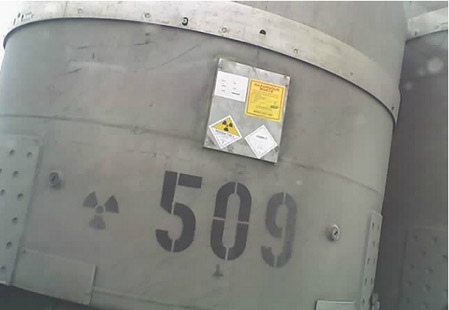
Low-level radioactive waste will be on trucks crossing Texas before long.
Photo courtesy mark gallagher at flickr.com/markgallagher/
State officials have given final approval to a plan allowing radioactive waste from across the country to be brought to Texas for storage. For StateImpact Texas, KUT’s Mose Buchele reports that the waste has people watching its transportation and storage closely.
We also want to make sure that it’s packaged properly, and that somebody is looking at all of those aspects.
Listen to the news story at KUT.
This document contains copyrighted material whose use has not been specifically authorized by the copyright owner. SEED Coalition is making this article available in our efforts to advance understanding of ecological sustainability, human rights, economic democracy and social justice issues. We believe that this constitutes a "fair use" of the copyrighted material as provided for in section 107 of the US Copyright Law. If you wish to use this copyrighted material for purposes of your own that go beyond "fair use", you must obtain permission from the copyright owner.
Call for an end to nuclear power in San Antonio, Reactor safety and concerned scientists, CPS Energy plans and public opinion
MARCH 14, 2012
The QueQue
San Antonio Current
Call for an end to nuclear power in San Antonio
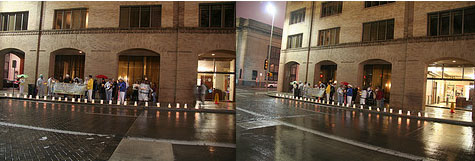
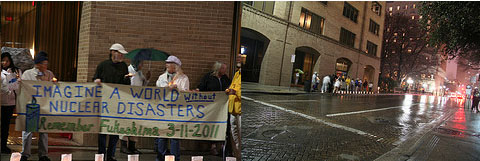
It was a dank, dark, drizzly Luminaria-less night, but a dozen-plus protestors trudged past the Federal Building downtown Saturday night with a banner calling on the few squinting drivers and umbrellaed pedestrians to "Imagine a World Without Nuclear Disasters." They walked down César Chávez Boulevard before hanging a right on Navarro Street to take up a position on the sidewalk outside CPS Energy‘s offices. Every few minutes someone tried to get a chant going, "Sayonara nuclear power" being the clunker in the bunch, and members of Energía Mía lit candles to place on the curb in memory of not only the thousands that died following the 9-magnitude earthquake and resulting tsunami in Japan a year ago, but for the victims likely still to come from the radioactive contamination wrought by the triple meltdown and hydrogen explosions at the Daiichi nuclear complex at Fukushima. "I would like to see us go to a zero nuclear power position," said a bearded Allen Townsend, who has tracked energy issues since the 1970s. "My big concern is the waste. Some of that waste is like a 20,000-year half-life, and I don’t think we can take care of something that long. That’s mortgaging the future."
Former City Councilmember Maria Berriozábal, the lone council opponent to STP 1 and 2 when they were constructed in the 1980s, said she hopes the units now being reviewed for license extensions that could have them operating until almost 2050 instead of shuttering in the late 2020s fail the test. "They’re old. They’re shut down as we speak because of problems. And we’ve seen all the problems that we’ve had in other cities," she said. "We should just concentrate all of our efforts on the good job that CPS is doing on sustainable energy and just quit nuclear energy." Lamenting the health risks that come from nuclear, former elementary teacher Helen Villarreal agreed, adding that the United States is losing an opportunity to be a leader in the field of low-polluting energy sources such as solar, wind, biomass, and geothermal.
Radioactive contamination from what may be the world’s worst nuclear disaster has blanketed the countryside around Fukushima and poured into the Sea of Japan, contaminating many domestic products and impacting the nation’s export business. Radioactive fallout was even tracked to cities in the United States. While regulators insist the minute levels of radioactive cesium and iodine, for instance, don’t pose a health risk here, two researchers publishing in the International Journal of Health Services found that 14,000 "excess" U.S. deaths – particularly among infants – may be linked the radioactive fallout from Fukushima. The gap represents the same sort of double-minded approach within the research community that still divides opinions about the Chernobyl nuclear disaster of 1986. An international collaboration of researchers have pinned the estimated fatalities linked to Chernobyl at 5,000 nearby and about 30,000 worldwide. However, reports filed by physicians in Ukraine and Russia published by the New York Academy of Sciences claim the death toll wrought by Chernobyl has already approached a million dead.
Reactor safety and concerned scientists
As some of the last reactors to go online in the U.S., STP also enjoys one of the stronger safety records in the fleet, said Buddy Eller, spokesperson for the STP Nuclear Operating Company. And if Fukushima Daiichi’s disaster was brought on by the loss of connection to the electrical grid from earthquake damage and backup generators swamped by the resulting tsunami – a double-whammy above and beyond what the reactors were built to sustain – Eller expressed confidence in STP’s three emergency safety systems that include "locomotive-sized" diesel generators in "flood-proof" concrete bunkers. Annual Assessment letters from the U.S. Nuclear Regulatory Commission for 2011 dated March 5, 2012, also give Texas nukes, the South Texas Project and Comanche Peak in North Texas, clean bills of health. "The NRC determined that overall, South Texas Project Electric Generating Station Units 1 and 2 operated in a manner that preserved public health and safety and met all cornerstone objectives."
But the Union of Concerned Scientists blasted the U.S. Nuclear Regulatory Commission in a report last week for failing to enact key recommendations from its own post-Fukushima assessment. "Many of its proposals to safeguard against such a calamity here are good in principle," the report states, "but their effectiveness will depend on how well they are implemented, and how quickly." High on their complaint is the NRC’s unfulfilled charge to clarify "patchwork" regulations for severe accidents (those exceeding the abilities of the plants to withstand, see Fukushima). In fact, such action, while highest on the NRC’s list of priorities, will be some of the last actions to be implemented, the UCS report states.
CPS Energy plans and public opinion
Plans to double the 1,080-megawatt nuclear-power complex in Matagorda County responsible for a full third of greater San Antonio’s power fell through after ballooning expenses in 2009 gave way to internal bickering and lawsuits between partners CPS, NRG Energy, and Toshiba in 2010, but members of Energía Mía want the city to fully divest itself from what they consider an "unforgiving" power source. It’s a non-starter at CPS, where an emailed response to questions on the subject reads simply: "CPS Energy has not evaluated elimination of nuclear from its energy portfolio and does not have any plans to do so." Whether STP 1 and 2 will be closed in 2028 or 2048, increased maintenance and repair will be the name of the game for years to come. Unit 2, for instance, has been offline for several months now as crews work to replace a rotor in the main generator, Eller said. Yet in order to fulfill its goal of 20 percent renewables by 2020 and a full 65 percent of its energy supply from "low-carbon" sources, CPS is pursuing non-nuclear and non-coal options vigorously. "Mothballing Deely in 2018 and acquiring a gas plant to replace Deely’s 870 MW along with wind, solar and clean coal is helping us get there," spokesperson Christine Patmon said. CPS announced this week that it is purchasing an 800-megawatt combined-cycle gas plant in Seguin. In January, a deal for 400 solar megawatts from OCI Solar was announced. How well the "bridge fuel" play on natural gas works out will hinge a lot on the environmental costs of shale gas development and the durability of formations like the Eagle Ford in South Texas (see "Inflated figures").
Meanwhile, a recent survey by ORC International performed Last month for the Civil Society Institute found that 57 percent of Americans (extrapolated from a survey of 1,032) are less supportive of nuclear power post-Fukushima. "This survey is another piece of bad news for new nuclear construction in the U.S.," said Peter Bradford, a former NRC commissioner and current adjunct law professor on nuclear power and public policy at Vermont Law School, said in a prepared release. "The nuclear industry has spent millions on polls telling the public how much the public longs for nuclear power. Such polls never ask the real world questions linking new reactors to rate increases or to accident risk. Fukushima has made the links to risk much clearer in the public’s mind."
This document contains copyrighted material whose use has not been specifically authorized by the copyright owner. SEED Coalition is making this article available in our efforts to advance understanding of ecological sustainability, human rights, economic democracy and social justice issues. We believe that this constitutes a "fair use" of the copyrighted material as provided for in section 107 of the US Copyright Law. If you wish to use this copyrighted material for purposes of your own that go beyond "fair use", you must obtain permission from the copyright owner.
Petition to NRC for Rulemaking to Improve Emergency Planning Regulations
February 15, 2012
The Sustainable Energy and Economic Development (SEED) Coalition is among the original petitioners on the Petition for Rulemaking to Improve Emergency Planning Regulations (10 CFR 50.47)
![]()
From Petition:
Petitioners request the U.S. Nuclear Regulatory Commission (NRC) to amend the NRC’s offsite emergency planning regulations in 10 10 CFR § 50.47 and Appendix E to Part 50, as well as including these modifications within 10 C.F.R.§52 Licenses, Certification and Approvals for Nuclear Power Plants for new reactors. These amendments include, among other provisions:
- Expand the radius of the Plume Exposure Pathway Emergency Planning Zone (EPZ) from a 10-mile radius to a 25-mile radius;
- Establish a new 50-mile radius Emergency Response Zone, with more limited requirements than the EPZ;
- Expand the radius of the Ingestion Pathway EPZ from the current 50 mile radius to a 100- mile radius;
- Ensure that emergency plans are tested to encompass initiating and/or concurrent natural disasters that may affect both accident progression and evacuation conduct.
Statement:
“Evacuation planning for a nuclear reactor accident at Texas reactor sites is crucial since the longer people are exposed to radiation, the higher the health risks. Expanding the distance for evacuation makes good sense, especially after witnessing the Fukushima nuclear disaster. Another safety concern in Texas is that there are no full-time paid professional fire departments in the counties where nuclear reactors and a radioactive waste dump are located and or adequate plans to rapidly distribute potassium iodide if needed,” said Karen Hadden, Executive Director of the Sustainable Energy and Economic Development (SEED) Coalition.
Take Action:
Related:
- Emergency Planning For Nuclear Disasters NIRS Factsheet Feb 2012
- Groups: Southern Company Does Not Have Real "Skin in the Game" if Vogtle Reactor Loan Guarantee Defaults NC Warn 2/23/12
- Click here to find out how close you live to a nuclear power plant in the United States.
Two New Reactors
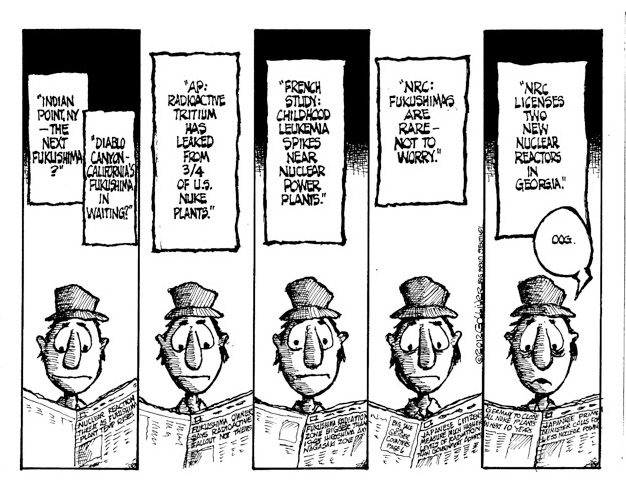
Couresy of Gary Olvier, cartoonist


